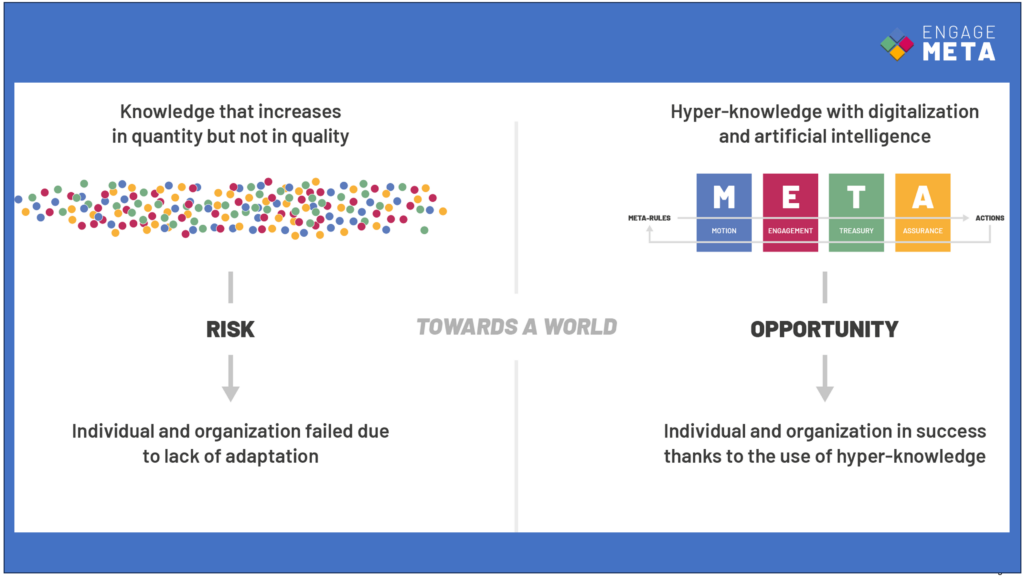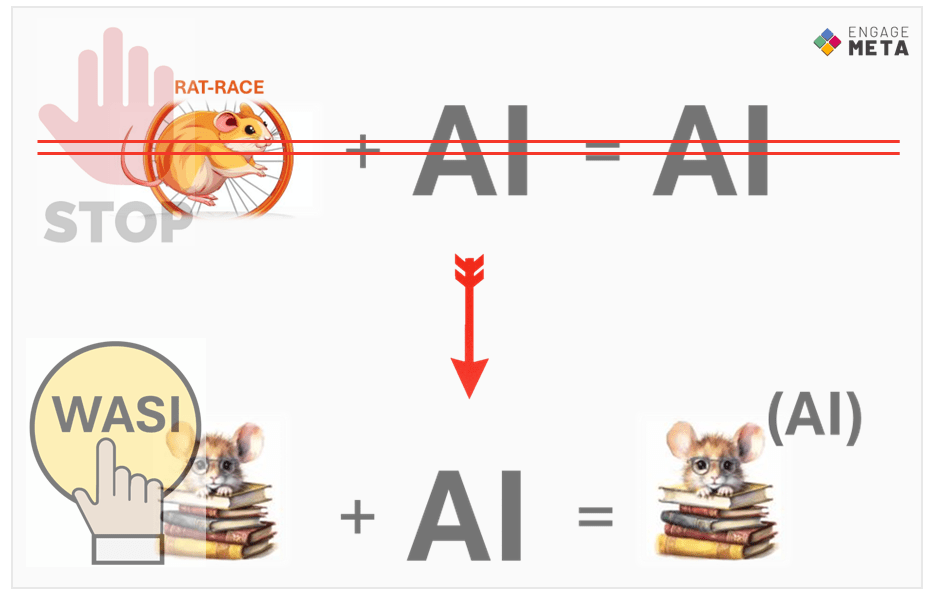MINDSET
Critical thinking

In this sphere, you will find key principles to help raise awareness that AI necessitates a profound change in the relationship between humans and work. With the increasing intelligence of systems, it is no longer sufficient to simply execute standard and repetitive processes at work. Such processes will simply be automated by AI. Everyone must then formalize their knowledge clearly and precisely. Humans, therefore, need to enhance their work capabilities through innovation, creativity, critical thinking, and sharing. It is essential to break out of the rat race and cultivate a culture of intrapreneurship and interpreneurship. Without the right mindset at work, AI will replace positions where the added value becomes low.
Download this slide deck (PDF) (+30 slides) to discover the world of META for entrepreneurship and intrapreneurship (Motion, Engagement, Treasury, Assurance).
The WASI process
WASI stands for: Write, Analyze, Share and Innovate.
How to escape the intellectual rat race that hinders your progress in projects and may become fatal with the rise of AI? Being in the rat race is like going around in circles in your work and life without seeing how to improve your future. When you let time pass without taking control, you end up no longer fighting for a better future and merely hanging on day by day. You work somewhat like a robot and distract yourself with social media and easily accessible leisure activities.
This procrastination is a poison that prevents us from building beautiful things and progressing harmoniously. To overcome it, you need to find reasons to act and even an obligation to take action. I try to provide some guidance on how to achieve this in my book “The META-Entrepreneur,” but here I want to emphasize the opportunity AI offers to help you escape the rat race.
But be careful, to fully utilize your AI assistants, you will need to learn to write with high precision. This is the only way for the AI to truly understand you and respond with relevance and high quality. You will also need to develop a critical mind to analyze the AI’s responses and ask it to redo, adjust, correct, clarify, rephrase, complete, and justify the results. This cycle of writing and critical analysis will significantly increase your intellectual capacity. It’s the opposite effect of TikTok, which tends to dull the mind.
It’s quite simple to understand, and it boils down to two principles:
- Firstly, to use AI effectively, you will need to completely take control of your way of thinking and working. You can no longer be passive and perform tasks like a robot. This applies to all professions, even if you are a software developer. You will need to think more before acting to better understand what you are doing so you can formalize it in writing and then use it to train your personal AI assistants. You will then do this collectively, following your managers’ guidelines.
- Secondly, you are no longer alone in facing your anxieties and blockages when moving forward and taking action. The more you enrich your AI assistants, the more they will help you find positive solutions to create your projects and improve your working conditions. As your AI practice improves, you will also be able to find AI assistants on the market that suit you best. No discipline or field of knowledge is inaccessible to you thanks to AI. You have access to a powerful intellectual force for just a few dollars a month with ChatGPT 4o. There’s no need to wait for your company to provide you with this tool; you can use it at home with your own data.
That’s not all! Writing and analysis will also allow you to discover new things and therefore innovate. Your creative intelligence will unlock, and you will then leave the rat race to become an augmented person thanks to AI. Finally, if you work in a team, you can share your knowledge with others to further increase your capacity to innovate.
Ultimately, the Write, Analyze, Share, and Innovate (WASI) cycle is the key to unlocking the infernal cage of the rat race.
Use the META to evaluate your state of mind

MOTION: clarify your DNA
The Motion element should help you find a deep and lasting reason that compels you to act positively. It is not just about motivation, which can fluctuate depending on circumstances, but an obligation that forces you to act positively even when you are tired or discouraged. Tenacity in overcoming challenges and accepting a time horizon of several years before achieving success are crucial for having a good Motion. By clarifying the deep reasons that drive you to act, you can more concretely define your roadmap in the next element, Engagement.
Question: What is your obligation to succeed?

ENGAGEMENT: accumulate knowledge to act better
To increase your chances of success, it is better to clarify what might cause you to fail rather than seeking the right idea to succeed. It’s similar to choosing a partner in life: if you focus only on their qualities without considering their flaws, the chances of the relationship lasting are slim. Conversely, if you eliminate people whose flaws seem insurmountable to you, then the remaining individuals will offer a greater potential for the future. The Engagement element forces you to write down the actions that will prevent you from failing, and success will then come from your daily efforts and sometimes also from luck. Take the time to thoroughly establish this list of actions to avoid failure, update it regularly, and accumulate as much knowledge as possible to keep them under your control.
Question: What are the important points that could cause you to fail?

TREASURY: keep your financial independence
Whether you accept it or not, money is fundamental in our lives, both personally and for carrying out projects such as running a business. You need financial education to establish your action plan to achieve financial independence and perhaps one day financial freedom. If you think that money is just a flow (expenses, debts) without understanding that it allows you to build a lasting stock of value (assets, profit), then your future is compromised.
Question: What is your relationship with money?

ASSURANCE: protect your assets
In the Assurance element, you need to clarify the legal and governance framework to protect yourself, your family, and your projects such as a business. There is no point in creating value and being ambitious if everything can collapse due to a legal mishap. Learn at least some basic concepts about governance aspects to protect yourself.
Question: what is your level of legal protection?
Entrepreneur: increase your success with the META
Entrepreneurship is a complex field that cannot be reduced to a personal experience, even if it is the journey of a successful entrepreneur. Social background, ambition, luck, lack of opportunities and encounters with co-founders all change the destiny of project holders. To succeed in entrepreneurship (and intrapreneurship as an employee), your social background and your lucky star are as important as your intrinsic qualities and any business management method.
However, one should not expect to become a successful entrepreneur accidentally or under social pressure. If you start a business just to add a line on your resume or to entertain your friends, the probability of success is even lower. Very few entrepreneurs reach a level they consider satisfactory. Most fail fairly quickly, and those who last longer are often trapped in an activity that does not pay more than a salaried job, with the added burden of responsibility. To really succeed, you need to have a plan, a long-term vision and a strength within you that is similar to a powerful ego for confidence and an inner determination to act.
Early in my career, I realized that I had something more in me than others to launch into the business world myself. In my first job, no one forced me to be an active employee while I already had an entrepreneurial mindset (intrapreneur). I then took charge of my career by building offers on behalf of my employers. I wanted to understand the whole business rather than being stuck in an executing role. In other words, I never responded to a job post, but always contacted my future employers to with offers that I had already prepared.
I was an “intrapreneur” and I took risks to succeed as an involved employee. I always had in mind that it’s easier to make excuses than to get approvals. So I took a lot of initiatives without waiting for them to be offered to me. After a decade of working as an employee, I started my first business already conditioned to succeed as an entrepreneur. Based on my experience, I will now give you some initial advice for each of the four elements of the META framework applied to entrepreneurship.

MOTION (Move)
If you can, you should take the time to experiment with entrepreneurship before you even start your business. This is a knowledge accumulation period that will better fuel your Motion element.
If you are an active and motivated employee, try the intrapreneurship option, otherwise invest your energy in a business alongside your main job (side business). You will then have more data to know yourself better and clarify your reason for being an entrepreneur. If you are already an entrepreneur, you will want to take stock of your DNA in the context of your current business. During the course of an entrepreneurial adventure, the entrepreneur may end up doubting his or her motivation to act. The difficulties of creating and managing a company can create a prison in which its raison d’être deteriorates. If you are in this situation, you need to reactivate your Motion and keep it at a high level to increase your chances of success. You will become anti-fragile to sustain great effort over the long term, while remaining in harmony with yourself.
You will see that you need to find an obligation to act in order to succeed rather than relying on a simple motivation that varies over time.

ENGAGEMENT (Act)
The Engagement element lists the fundamental and universal actions that the entrepreneur must not miss, such as exposing the intrinsic value of the offer, generating alternative income through the multiple cash flow strategy (tactical offer, integration in a value chain) or seeking a positioning outside the competition (outcompete).
It is in this element that the ability to formalize the company’s know-how is used as a strategy to generate alternative income. It is then a question of building a tactical offer to support the core business.
Mastering digitalization, it is possible to deploy online training, remote consulting, book publishing or working groups (think-thank) in order to diversify the sources of revenue and educate the market on the offers.

TREASURY (Finance)
The Treasury element focuses on the financing strategy of the business. The main objective is to help the co-founders keep control of their company as long as possible. It is therefore not about abusing bank leverage or fundraising. On the contrary, the objective is to fund the activity as accurately as possible by focusing on organic growth.
To achieve this, the multiple cash flow strategy is coupled with break-even point management on the tactical offer.
The entrepreneur must also master the methods of valuing the company and the calculation of the shares to be granted to an investor for a capital outlay. For example, you must control the risk of overvaluing the company in one investment round, which could dilute the co-founders in the next round (down-round). The more you strengthen your Treasury, the better you will control your fate towards investors.
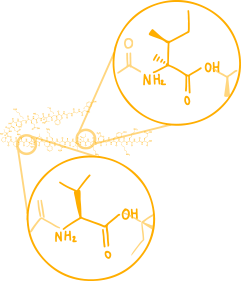
ASSURANCE (Protect)
The Assurance element is the foundation of legal protection. What good would it do you to create value with your company if a disagreement between the co-founders puts everything in question?
On the first day of business creation, all the project holders are in high spirits and the idea of defining rules for conflict resolution is not a priority. However, not addressing it early enough is a mistake that can be fatal. To counter this risk, the shareholders’ agreement is drafted at the same time as the company’s articles of association, i.e. on the day it is created. It is the guarantee of good governance.
For example, it specifies what happens to the shares of a co-founder who decides to leave the project prematurely, the remuneration of the managers and its evolution according to the success of the activity, the rights to buy and sell shares, the conditions to trigger a total sale of the company, etc.
Clauses on intellectual property rights are also specified, e.g. for software created before the company’s legal incorporation or on non-competition undertakings.
Another legal document contains the conditions attached to the shares purchased by the investor. This is where the preferred shares are described with their specific rights, such as accretion in case of deterioration of the valuation between two investment rounds, acceleration of dividends or the exit value multiplier for the investor.
These four elements of the META framework help the aspiring or existing entrepreneur to strengthen their chances of success. You can also apply these elements in your working domain as an employee to become more active and being an intrapreneur. By applying the rules proposed in the four elements of the META framework, you will become a meta-entrepreneur or an active employee (intrapreneur). You can find a detailed description of these rules in the book “Meta-Entrepreneur”.
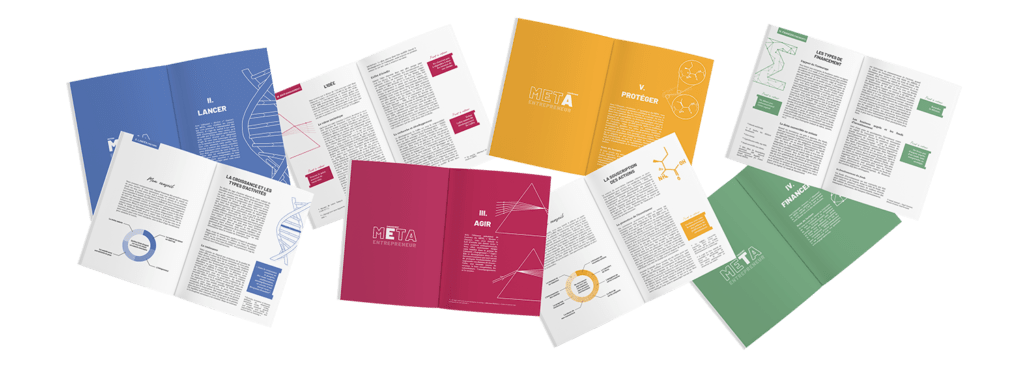
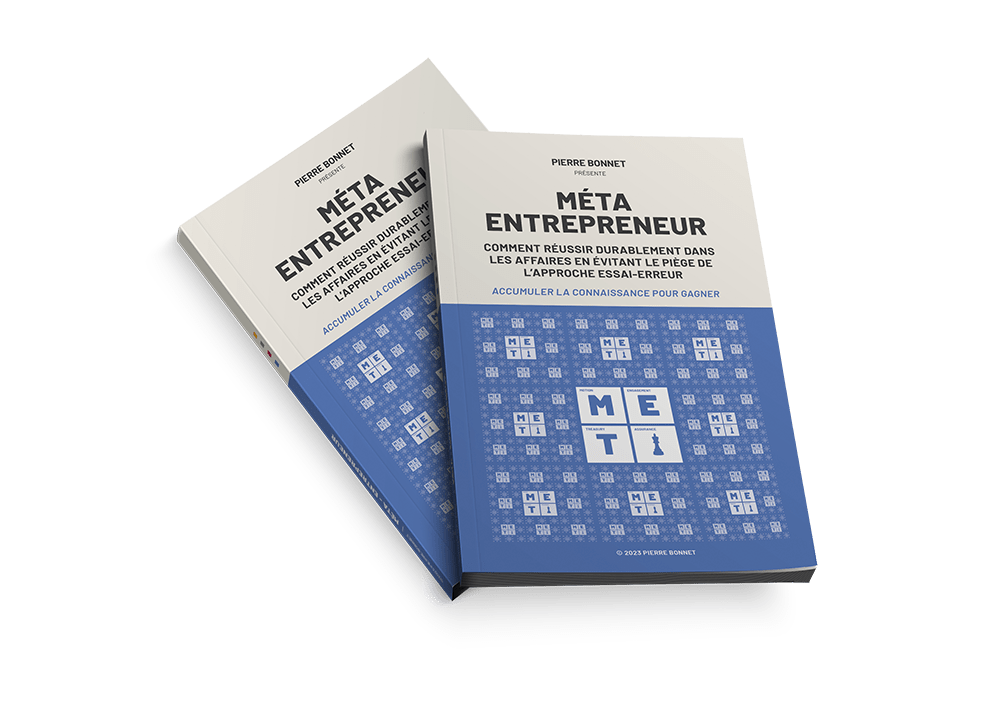
You will find in the book “Meta-entrepreneur” the story of my entrepreneurial journey with 11 dates that marked my adventure. you will also discover my obligation to act and the set of universal and fundamental rules (meta rules) for each of the four elements of the META Framework.

